These smart upgrades to make when buying a new manufactured home will get you the best home for the best price. We’ll help you understand where to spend your money so that you get a quality home at a fair price.
Buying a new home is a complex, stressful, and exciting ordeal. In this article, we offer 10 smart upgrades to make when buying a new manufactured home,
These upgrades offer the most benefits with the best return on investment.
Understanding the 3 Levels of Manufactured Homes
In the manufactured housing world, you absolutely get what you pay for. Manufactured home buyers should understand the different levels of quality available from most builders.
There are 3 levels of manufactured home models: the most affordable, low-end models, the mid-range models, and the high-end or luxury models.
The Most Affordable Home Models
The most affordable models will have staples and glue instead of nails, smaller studs, Chinese steel beams, low roof pitch, economy grade flooring, particle board, plastic fixtures, vinyl wallboards, etc. You won’t be able to upgrade these models too much. If your budget is at all flexible you will want to bypass these entry-level homes. You will find these homes on every dealer’s lot with large signs advertising double wides for $39,995 or single wides for $19,999
The Mid-Range Home Models
The mid-range models are the most popular and will have better everything: larger wall studs, better insulation values, higher grade flooring, exterior house wrap, drywall or wallboard nailed to the studs, higher roof pitches, etc.
High-End Luxury Manufactured Homes
High-end manufactured homes are top of the line. Construction is equal to or better than a site-built home. Materials are top grade. Simply put, everything is high quality.
In the manufactured housing world, you absolutely get what you pay for but that’s the brilliance of manufactured housing. We can get exactly what we need in a home.
Go with a model that offers the features and specs you want most as standard options and then add smart upgrades for your new manufactured home build.
Spend Money on Construction Upgrades
Most experts will advise new manufactured home buyers to spend money on construction upgrades before cosmetic updates.
You can’t go wrong with increased energy efficiency, better protection from the weather, and better construction specs. A better-built home will usually have a better resale value in the future.
Mid and high-range models will likely have the following options standard. If not, these are all smart upgrades for your new manufactured home:
- 30 Year Architectural Shingles
- Higher Roof Pitch (4/12 or more)
- At least 7.5-foot exterior wall height but 8-9 foot is best
- Thicker Exterior Sheathing
- 2″ x 6″ Exterior Wall Studs
- 2″ x 4″ Interior Wall Studs
This Palm Harbor Series information sheet shows the company’s standard features:
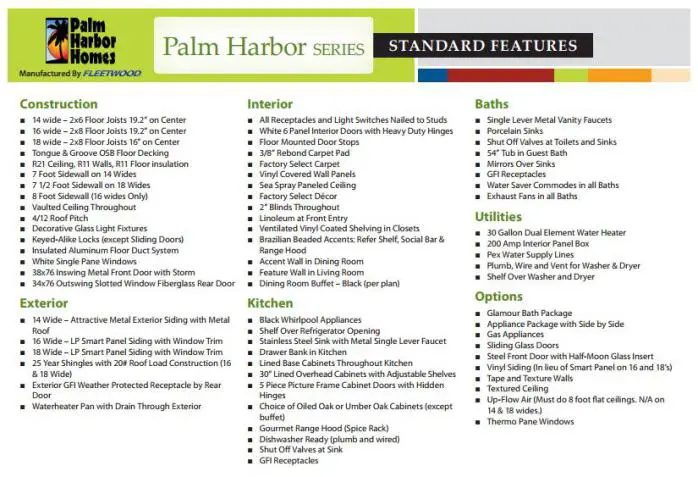
Smart Upgrades to Make When Buying a New Manufactured Home
1. Exterior Doors
Upgrading exterior doors is a relatively low-cost upgrade that adds lots of value to a home, including new manufactured homes. In fact, Remodeling Magazine has stated that upgrading a home’s exterior door has the highest return on investment of any home improvement upgrade.
Low-end manufactured homes will usually have aluminum doors that are 32″ wide and between 74″ and 78″. Mid-range model steel doors are usually 36″ x 80″.
The back door, which is usually the cheap gun slot or nine window style, is still the norm for both mid-range and top end homes. Upgrading to a 36″ x 80″ steel door with dual glazed windows and deadbolts is not a bad idea.
Make sure the door jambs are vinyl wrapped and not particle board for front and rear doors. Read More about Manufactured Home Renovations That Pay You Back
2. Interior Doors
The cheap 26″ x 74″ hollow core interior doors are standard on most manufactured homes, from low-end to luxury models.
Upgrade to the 30″ x 80″ wood framed or paneled hollow-core interior doors. This will make a huge difference and help make the home look more like it was site-built.
The solid wood 6-panel interior doors are especially beautiful but they can get pricey – remember you are replacing every door in the home. Mortised door hinges are better than surface-mounted.
3. Windows
Better windows are extremely smart upgrades for your new manufactured home.
Most new mid-range manufactured homes have an energy-saving thermal pane window, probably aluminum framed with a single pane for the low-end models.
Windows impact your energy costs and both the interior and the exterior aesthetics of a home so it’s a smart investment to upgrade to the best windows you can afford.
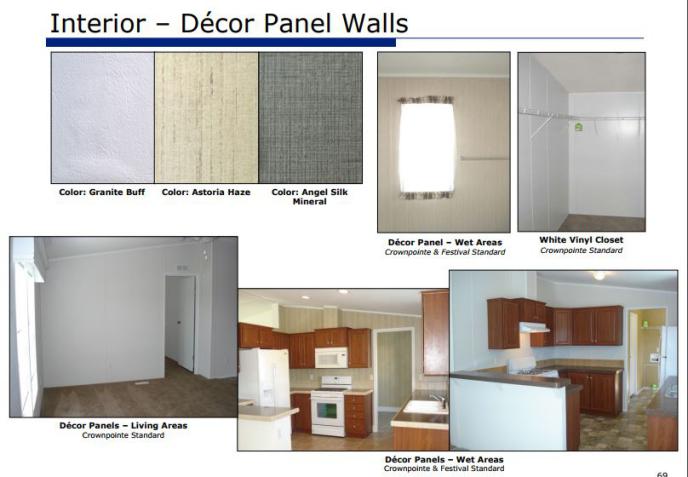
Decor panel wall patterns shared in the 2015 Fleetwood Options Catalog,
4. Sheetrocked Walls
Walls are a hot topic in the manufactured housing world.
For decades, many factory-built homes had faux wood paneling or VOG wallboard. VOG stands for vinyl on gypsum and is a form of cardboard wrapped in vinyl.
Due to the transportation needs of a manufactured home, it was difficult to use sheetrock because it required extensive finishing work after installation. Fortunately, customer demands are changing the industry and nowadays we can have sheetrock in our homes.
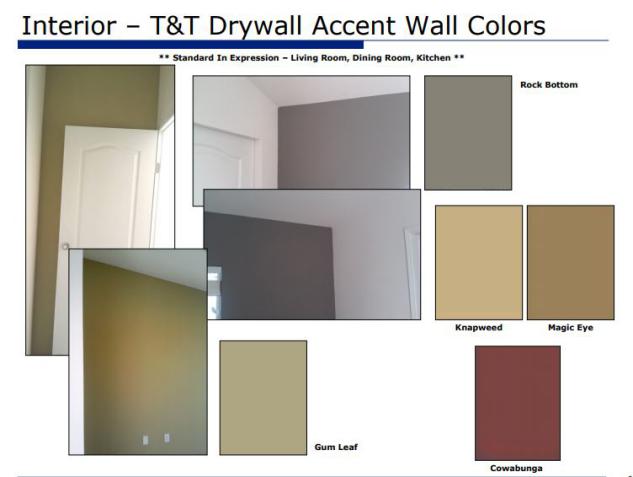
Drywall is now usually standard in some rooms on higher end single wide and double wide homes, now.
Steve Lancaster, our fav mobile home expert, states that the sheetrock used in manufactured homes are much thinner than the sheetrock used in stick built homes. This is done to make it lighter but it cracks more when being transported to the lot or when settling later. He often prefers to get the vinyl coated wallboards and paint them, leaving the “strips” on. Learn how to paint vinyl coated mobile home walls here.
If you prefer sheetrock, it’s definitely an upgrade that needs to be done at the time of construction in the factory.
5. Insulation
If I had to choose just one upgrade for my new manufactured home it would probably be the insulation (which would require thicker studs so I’d be cheating a bit, I guess).
There are three important areas of insulation in a manufactured home: roof, sidewall, and flooring. Flooring and roofing insulation will have a higher R-value than your sidewalls.
Low-end model homes will have sidewall insulation with an R-value of 11, maybe 13, standard. Upgrade to the highest you can afford (22+).
Better insulation is especially smart upgrades for your new manufactured home if you live in an area with extreme temperatures (really cold or really hot). Learn about Upgrades that Will Reduce Mobile Home Heating Costs here.
These vinyl siding upgrades are from the 2015 Fleetwood Options Catalog.
6. Vinyl Siding
Steve gave us lots of great information about buying a new manufactured home. He listed10 smart upgrades to make when shopping for a new manufactured home.
Steve explains, “In most of the country, vinyl siding and shingle roofs are now standard, even on the cheapest homes. In some parts of the country, usually out west, metal siding and metal roofs are still an option. A product called “Smart Siding” is available in the western states but occasionally in the East. It is supposed to be much stronger and more durable than the old Masonite (particle board) siding used from the 1970s through the 1990s.”
Steve continues, “One thing I have noticed is that in my area, vinyl sided homes usually have nothing behind the vinyl except white foam insulation, Upgrading to OSB under the vinyl is sometimes an option in low-end homes, and is usually included when the wind zone increases to 2 or 3.
Most new homes use this foam under the vinyl even if they are very expensive, so look before you buy. I have often wondered how this foam does in preventing water getting into the home through the vinyl siding. As we all know, vinyl siding can and does come off in high winds. Once it is gone, gaps in the foam insulation will allow any wind-driven rain into the walls.”
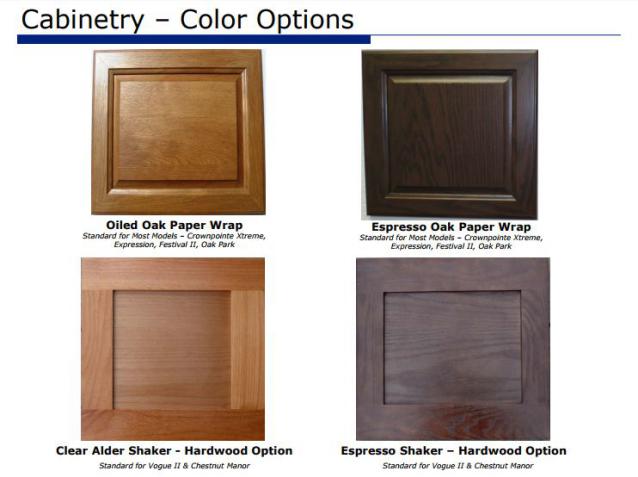
7. Cabinetry
Cabinets have a huge impact on a home. You may never realize just how much you use cabinets until one gets broken so they are certainly smart upgrades for your new manufactured home.
Generally, low and mid-range homes have smaller MDF cabinetry with either a ‘real wood’ paper veneer glued to it or it will be wrapped in vinyl.
n many cases, these cabinets don’t even have their own bottom shelf, you only see the room’s vinyl flooring when you open the door.
Cheap knobs and exposed hinges are also common with cheaper cabinets.
Solid Wood
Cabinetry made from solid wood is not cheap or lightweight so it is an expensive upgrade for your new manufactured home but it can be a great investment.
Upgrading to real wood cabinets in industry standard sizes (36″ for floor and 31″ for upper) can greatly increase the home’s resell potential.
Steve warns, “One thing to note, even top end homes often use the cheaper cabinet materials inside and out. They may look fancier and may be taller and have the crown molding and raised panels, but inside they still use the cheaper vinyl wrapped or even exposed unwrapped particle board shelving. Schult is an example of that. Upgraded cabinets are offered by many factories. You can ask to find out.”
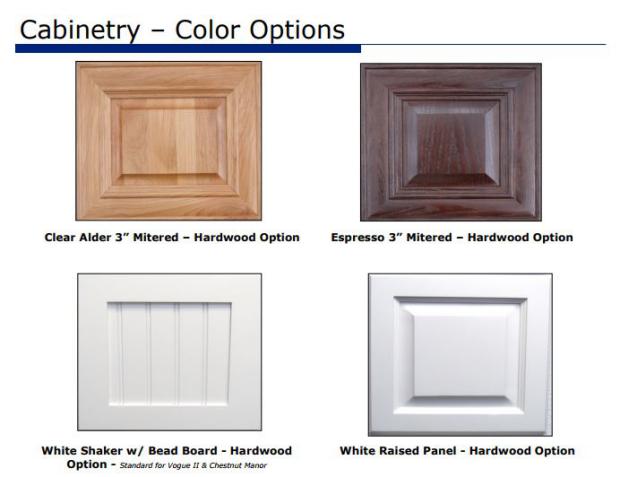
8. Flooring
Sub-flooring, or decking, is a common complaint among manufactured homeowners. The low and mid-range homes will usually use 5/8″ particle board for the home’s sub-floor. Particle board does not hold up to water at all. Even a small leak can swell the floor up and require a full replacement.
More smart upgrades for your new manufactured home is upgrading the decking to at least 5/8″ plywood or to the newer materials called Novadeck or Cresdeck.
In addition to particle board decking, low-quality carpet is used in all three quality levels of manufactured home models.
Carpet quality is measured by weight per square foot. Low-quality carpet will be around 15 ounces or less. Ideally, you will want at least 19 ounces. If you want durable and comfortable you will need to upgrade to a higher quality carpet than what most builders offer standard.
Is Installing Vinyl Tile in Manufactured Homes Smart?
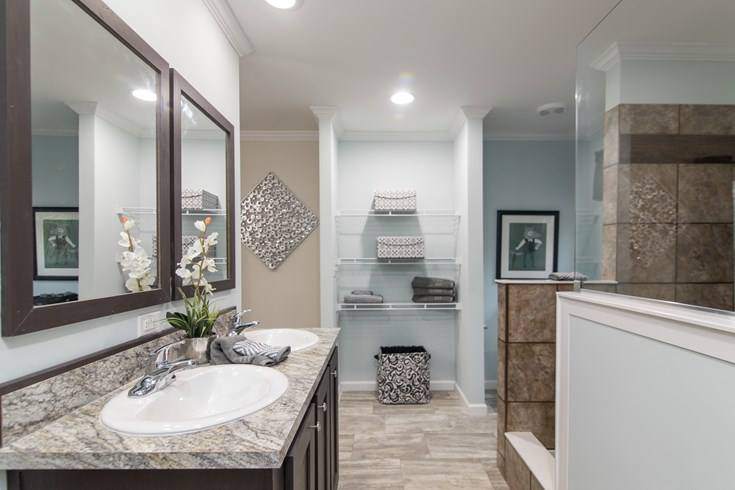
9. Sinks, Showers, and Tubs
Another area you need to consider upgrading is the quality of the sinks, showers, and tubs in your new manufactured home.
Steve gave us a few tips, “Plastic vanity sinks have good durability but they do stain and discolor easily. Upgrade to ceramic if you can. Standard tubs are often made of thin plastic so upgrading to fiberglass is a good idea. Showers can now be one piece fiberglass, two-piece plastic, or have a plastic or fiberglass floor with a tile surround. ”
Read More: See the entire 2015 Fleetwood Homes Options Book here.
10. Exterior Sheathing and/or Belly Wrap
Giving your home extra durability and stability, by adding another layer to its structure is a smart move. You want sheathe between your insulation and siding. No vinyl siding screwed directly into the home’s studs. Ever.
The belly wrap is pretty important since it protects you from so much. If the option is available, insist on thicker material.
10 smart upgrades to make when shopping for a new manufactured home
This is by no means a complete list of smart upgrades to make when buying a new manufactured home or exactly what to look for when purchasing a new home but it should help a bit.
Focus your upgrades on construction more than aesthetics.
Did you order a manufactured home with upgrades? Tell us about your experience below!
Thank you for reading Mobile Home Living!
We couldn’t have created this article without help from Steve Lancaster, our favorite mobile home expert. He founded the popular Facebook group, Manufactured Housing and Mobile Homes, and posts helpful ideas and examples of great homes on a near-daily basis. His passion and knowledge of mobile and manufactured homes are impressive and we are very thankful to have him help us list these 10 smart upgrades for new manufactured homes.


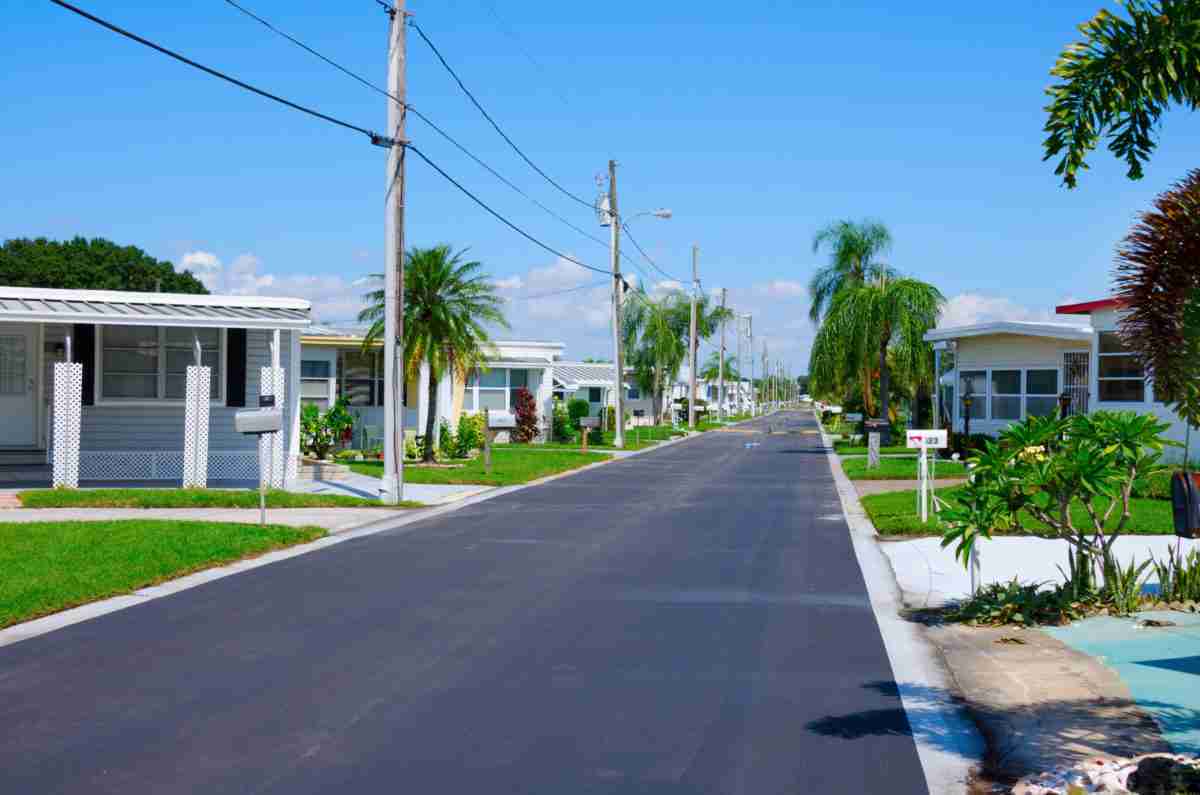

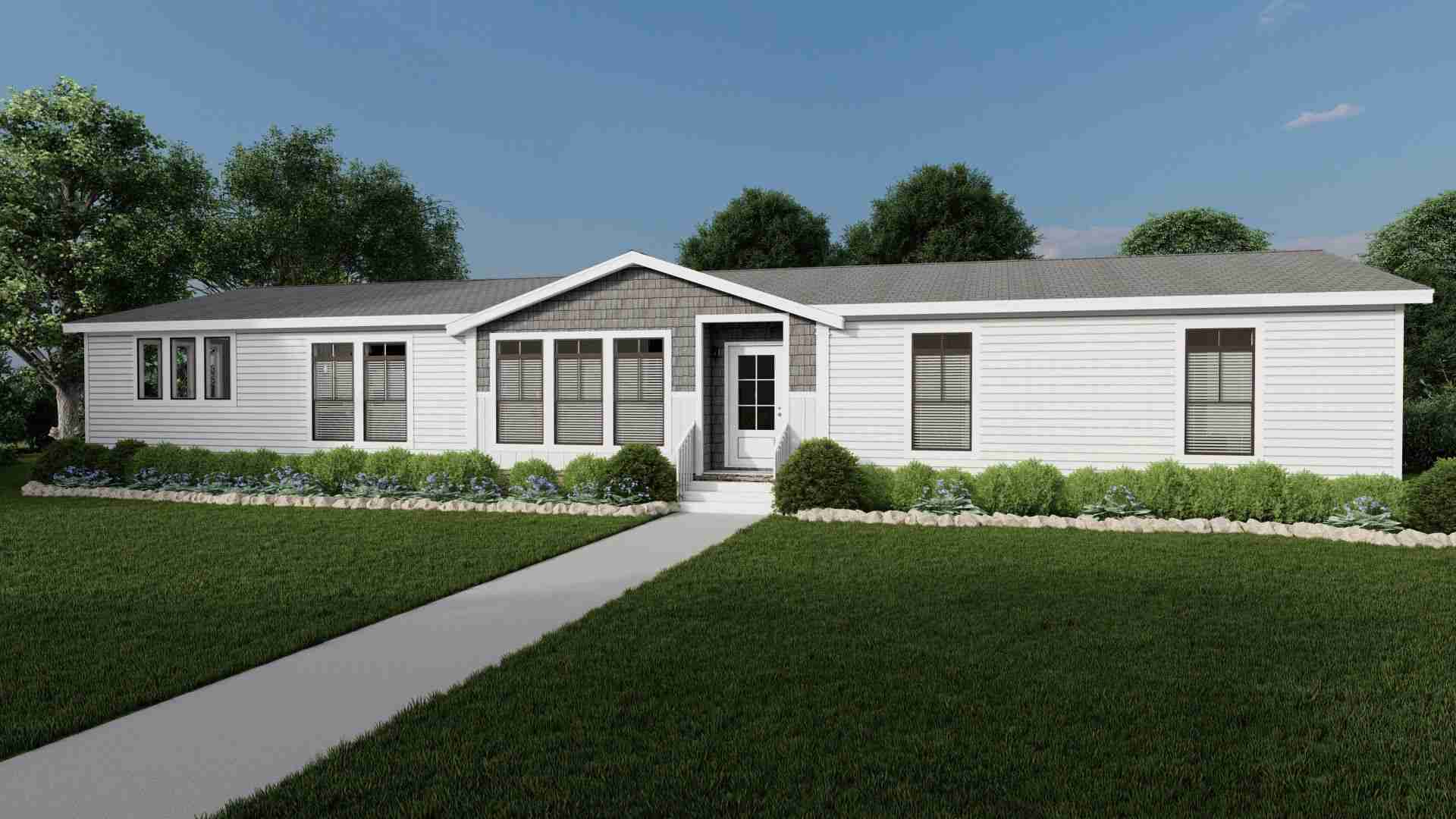
This article have been really helpful and I’ve taken a lot of notes because I’m looking at buying a manufactured home in AZ where it’s really hot during the summer. Any tips on what to upgrade due to the heat?
Hi Ron,
Yes, it’s likely possible but if you insist on all of those upgrades it may be best that you buy a site-built home. I say that because by the time you pay for all the upgrades on a manufactured home your cost per square foot is going to be real close to that of a site-built home. Add the transport and installation and it could be equal. If you keep it as personal property and not permanently install the home it the lower taxes may help and make the manufactured home a better option.
Of course, the west coast of CA is a whole different ball game and you’ll need to speak to experts in that area to see if it makes sense to go with a manufactured home (it likely will).
Best of luck!
I’ve considered buying a manufactured home and I currently live in a large two story house that is 2600 square feet (131 yrs old). Therefore, I’d like to get all these upgrades but I’d also like ceramic tiled bathrooms, granite countertops, thick solid oak hardwood floors and hardy-plank siding with a sub-wall between exterior and interior walls. Is this possible in a manufactured home? Thanks
Hi Cheryl,
I’m so sorry. There is at least a one year warranty on all manufactured homes sold in the US. I imagine there would be a better warranty in Canada and as long as you made a verbal or written complaint to the dealership and/or builder you should have no problem getting the issues repaired. Best of luck!
Hello, love this newsletter! We purchased a modular home 2 years ago from Skyline Homes out of Oregan (We live in British Columbia Canada). After studying the homes available we chose Skyline because they offered higher end options. However, the finish product is terrible. We went for drywall, 9 ft ceilings, 5/12 pitch, Hardy Board siding, interior window cornices, recessed lights, crown molding. The drywall install is terrible, with gaps in corners, walls that are bowed, joints opening, screw (probably nails) not flush. Crooked walls so the base boards need adjusting. Not enough electrical outlets and switches, recessed lights in the wrong rooms, the siding is low quality the install is amateur the soffits and fascia are poorly installed plus they look like painted plywood, it appears we have no vapor barrier on the inside between the insulation and drywall…. I designed a very unique plan and that part we are happy with, but we are ashamed by how it appears we were “taken”. We have something in our walls and ceiling that is either mice or bats and my husband can see in the attic to the outside in many areas. We did our best to pick a good home and feel cheated. We are on a very limited income and sold our conventional home to live debt free.
Hi Rashad,
Thank you for such an informative comment! Unfortunately, there are a lot of manufactured homes that didn’t have exterior sheathing. My father’s brand new 1986 Redman double wide didn’t have exterior sheathing under the vinyl siding. Perhaps you are in a different zone and homes around you are built to tougher regulations? Thanks for commenting!
Hi, I live in Southwest Mississippi and is close to the Louisiana state line. So I have been to a lot of manufactured home dealers within a 120 mile radius. I have lived in manufactured homes my whole life and still do and I have never seen a manufactured home without exterior wall sheathing behind the vinyl siding, floor cabinets without bottoms in them, particleboard sub floors, or exterior/interior wall studs smaller than 2×4. Even the low end homes are built with O.S.B wall sheathing, bottoms in the floor cabinets and most come standard with T&G O.S.B sub floor or T&G plywood subfloor as an upgrade. Every home I’ve owned came standard with 3/4 T&G O.S.B sub floors, 2×4 exterior/interior wall studs and 1/2 inch taped and mudded sheetrock . In recent years most homes in my area use 2×6 exterior wall studs on 16 inch centers with R-19 insulation, 2×4 interior studs on either 16 or 24 inch centers, 3/4 T&G O.S.B or plywood sub floors, 7/16 O.S.B exterior wall sheathing with whole house wrap and 2×8 floor joist on 16 inch centers with a double perimeter band for extra strength and rigidity all standard. The cost is more but it is a much better built house. They usually run between $80,000 and $125,000 for a double wide and between $140,000 and $180,000 for a triple wide home with some on the higher end running $200,000 and up for the 7/12 or 9/12 roof pitches, upgraded structure, wiring, plumbing and usually comes with a concrete slab from some builders. There are no builders here that still use metal siding on a home. They stopped building them here with metal siding over 15 years ago. I always look at the structure of the home and certain brands for quality, build specs and the dealer for customer service during and after the sale and their craftsmanship while they set and finish out the home.
I love reading comments like this! Thank you, Toni! Best of luck on the house hunt! If you have any questions or if I can help at all just email or write a comment (email is crystaladkins @ mobilehomeliving.org).
Thanks!
Your website is helping me to learn what to ask. I looked at manufactured homes last week and of course like many people you go for the one you like the way it looks. Now I am getting educated on looking into which manufactured homes are built better for what I can afford. Then pick from those and see what upgrades I can get. Thanks! Great information
Hi Leah,
I’m a big fan of a mixed siding with vinyl stone veneer – I think in the right places, that different mix of materials really makes a mobile home look great. Here is our mobile home siding guide that should help you a lot.
My mobile home is excellent on the interior. I want the outside to look like a home. Currently we have a metal roof which looks good except for the pitch. We will build some type of wrap around deck/porch. What can we replace replace the current siding with? Any idea of approximate cost for replacing siding on a double wide?
Hi Janelle,
The bathtubs are 6″ shorter and 6″ less narrow (wide?) and kids need a lot more room to play in the tub! If there’s a way you can find 6″ to install a standard $129 tub from Lowe’s the kids probably wouldn’t splash that much. Also, when you decide to replace the tub go ahead and replace the just the area at the tub with marine-grade plywood, it holds up against water better than regular plywood or OSB. Of course, anything holds up against water better than the MDF that most manufactured homes have.
Quality of workmanship is the main complaint against manufactured home builders and I can understand that they need to cut some corners to be profitable but some things are just ridiculous. I’m sorry you’ve dealt with it.
Hi,
I purchased a manufactured home two years ago and had it set on an acre and a quarter in Arizona. I love it here! And I’m not disappointed in my choice, but I am disappointed in the quality of a lot of the workmanship that went into the home. They were pretty sloppy and cut corners I think. Anyway, I would love to upgrade my front and back door and many of the other upgrades you mention I have had on my list to do at some point LOL my main concern is in the kids bathroom, the tub is so small and when they use the shower the water goes out on the sides. They are kids and did not think much of it, and I did not notice unfortunately until it was too late. I’ve got quite a bit of swelling and damage now in that bathroom. I’m thinking I need to have it fixed sooner than later. Thank you so much for your article and I read another one on this site that has helped me determine what needs to be done as far as replacing the flooring in that bathroom and getting marine-grade plywood. So glad I found this resource!
Hi Raylene,
I LOVE manufactured homes but sometimes a site-built home is the best choice. Ideally, I think the best deal is to buy an older pre-owned manufactured home and have it placed on your own private land and remodel it exactly how you want it. In Myrtle Beach, it makes no sense at all to buy a double wide and the best single wides are in 55+ parks. You can buy a 2400 sq ft two-story home on about half an acre for $20k more than an older double wide on the same size lot. I have no idea why.
Your heart will tell you when you find the right home. Best of luck!
Very informative article. I’m trying to make a decision about my future home, site built or manufactured???? VERY difficult to choose. I’ve visited many retailers in my area and have seen some beautiful homes but no decision yet.
Hi David,
In all reality, you should be fine as long as the tile isn’t mega thick and crazy heavy (I don’t like tile over marriage lines though). If you still have your owner’s manual there should be a section in it talking about weight per inch or weight load per foot. You can take the weight of the tile and match that using the formula for your home’s weight load.
Best of luck! Thanks for reading!
How do I know if my 1998 Redmond double wide can accommodate ceramic tile throughout? Not on a cement foundation but block piers. SE AZ high desert. TY
Hi, Don!
That’s way over my head but you got me interested so I did a Google search and found this article from Oberlin College called Windows, Light, and Heat Gain. They have the formulas laid out well. This PDF from Energy.gov is pretty thorough too.
Thanks so much for reading and commenting!
Nice article with reminders of everything to consider on a good to-do list! There is one thing that still puzzles me, though: The cost/benefit ratio of low-e glass windows – Letting infra-red radiation in during the day vs letting heat out at night. I haven’t figured out how to compute the trade-off, and for all I’ve been able to tell, there shouldn’t be a single window in the whole house!
Hi Thelma,
It sounds like you are doing a good job at making it liveable. I love the idea of putting plywood on walls! I’d love to see a photo when you get finished!
This email has been very interesting as I’m in the process of a fixer upper an ’85 Skyline. Had all the carpet removed and replaced with vinyl plank well worth it. The walls had vinyl wall someone tried to remove I’ve replaced with quarter inch plywood. Just trying to get it liveable.
Hi Joe,
You’ll probably need to frame it out yourself. I’ll let you research on that more since you know your layout and framing. Best of luck! (If you do add it please take photos of the process, I’d love to share that! Thanks!)
Great Ideas! I’m looking to install a barn door at my master bedroom entrance. There is no support in the closet to the door opening to allow me to properly install the hardware. Any ideas?!?!
Great article, very helpful!
So far, the most we’ve done to our 2008 Fleetwood is new carpet and paint throughout. Painted the existing porch, changed out the back door, added window tint to one bedroom and the utility room that receive all day sun, and changed out one toilet and one tub faucet. There more, of course. Isn’t there always, home or mobile home? lol